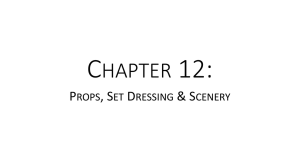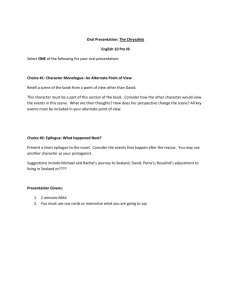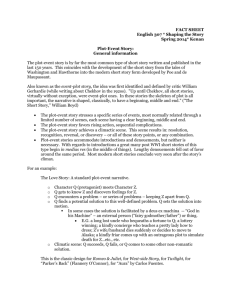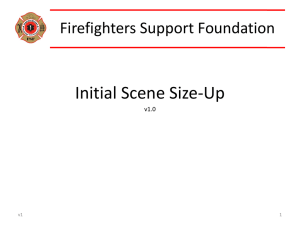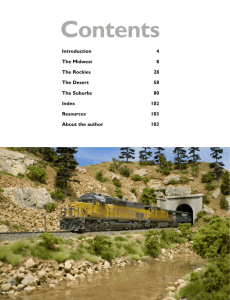Chapter 15 – Scene Design - Shelton State Community College
advertisement
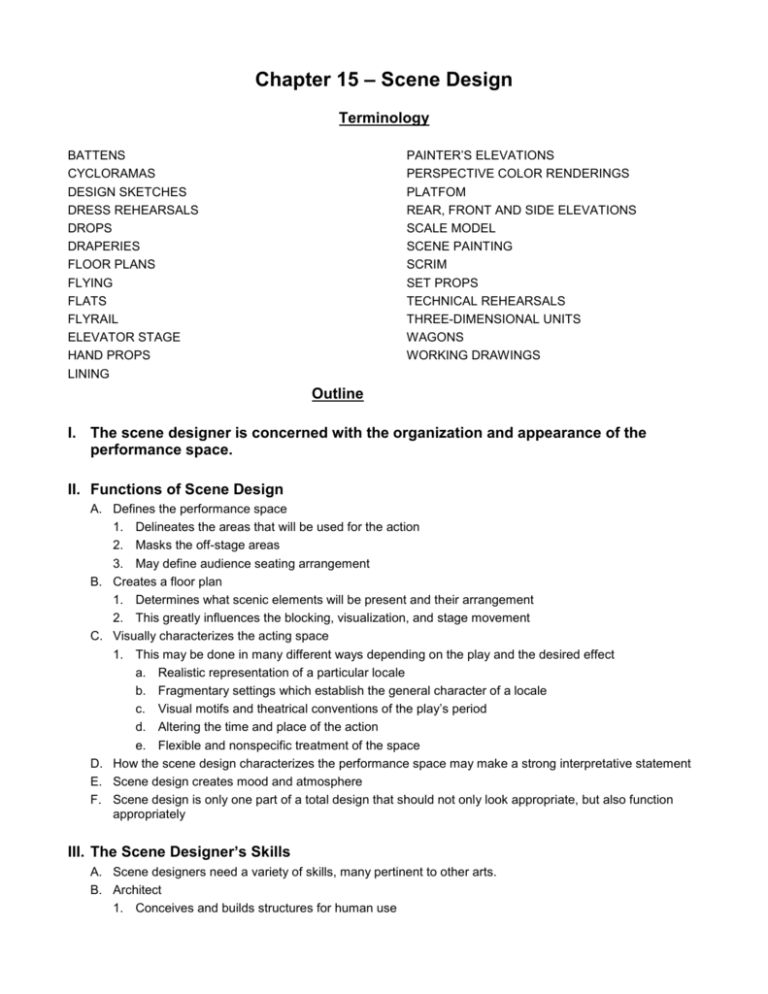
Chapter 15 – Scene Design Terminology PAINTER’S ELEVATIONS PERSPECTIVE COLOR RENDERINGS PLATFOM REAR, FRONT AND SIDE ELEVATIONS SCALE MODEL SCENE PAINTING SCRIM SET PROPS TECHNICAL REHEARSALS THREE-DIMENSIONAL UNITS WAGONS WORKING DRAWINGS BATTENS CYCLORAMAS DESIGN SKETCHES DRESS REHEARSALS DROPS DRAPERIES FLOOR PLANS FLYING FLATS FLYRAIL ELEVATOR STAGE HAND PROPS LINING Outline I. The scene designer is concerned with the organization and appearance of the performance space. II. Functions of Scene Design A. Defines the performance space 1. Delineates the areas that will be used for the action 2. Masks the off-stage areas 3. May define audience seating arrangement B. Creates a floor plan 1. Determines what scenic elements will be present and their arrangement 2. This greatly influences the blocking, visualization, and stage movement C. Visually characterizes the acting space 1. This may be done in many different ways depending on the play and the desired effect a. Realistic representation of a particular locale b. Fragmentary settings which establish the general character of a locale c. Visual motifs and theatrical conventions of the play’s period d. Altering the time and place of the action e. Flexible and nonspecific treatment of the space D. How the scene design characterizes the performance space may make a strong interpretative statement E. Scene design creates mood and atmosphere F. Scene design is only one part of a total design that should not only look appropriate, but also function appropriately III. The Scene Designer’s Skills A. Scene designers need a variety of skills, many pertinent to other arts. B. Architect 1. Conceives and builds structures for human use C. D. E. F. G. H. I. J. 2. Sculpts space 3. Concerned with function, size, organization, construction and visual appearance 4. Communicates ideas through scale models, and construction drawings Painter / Artist 1. Expresses ideas through sketches and drawings 2. Painted renderings, models, and painter’s elevations 3. Painting of scenery Interior decorator 1. Chooses furnishings, decorations, etc. Actor 1. Effective designers understand the characters who will inhabit their spaces Art historian 1. A knowledge of architectural styles and the history of decorative motifs and furnishings 2. Ability to draw upon various visual styles Stage historian 1. A knowledge of the theatrical conventions of other times, places, and cultures Scenery Construction and Painting A knowledge of new materials and technologies Computer literacy 1. The ability to use computer assisted design and drafting IV. Working Plans and Procedures A. There is no standard way of moving through the design process B. Preliminary designs 1. Sketches 2. Scale model 3. Design elements need to capture the dominant qualities of the dramatic action or the production concept 4. Designing is a constant process of reaction and revision C. Final designs 1. Perspective color renderings 2. Floor plan 3. 3-D scale model D. After the designs are approved, the designer makes working drawings – to scale 1. Rear elevations 2. Front elevation 3. Side elevations 4. Individual constructions drawings 5. Painter’s elevations E. Once the plans are completed, the construction phase can begin V. Basic Scenery Elements A. Traditional stagecraft practices still play a major role in most settings B. Designers use a few basic kinds of scenery units, and need to understand each kind of unit so they can combine them creatively to be both evocative and practical VI. Soft-Scenery A. Soft-scenery units are typically made of unframed cloth and suspended from overhead B. Drops 1. Used to enclose the setting 2. Sometimes framed at the top and bottom 3. Many drops are painted and some may have cutouts C. Draperies 1. Masking 2. Sometimes painted and used like drops, but completely unframed D. Scrim 1. Can be made to appear opaque or transparent 2. May be framed, or hung in folds E. Cyclorama 1. Generally a continuous, tightly stretched curtain, used as a backdrop 2. Its color may be changed through lighting and projections VII. Framed Units A. Some units are framed (on all four sides) to make them self-supporting B. Flats 1. Wood or metal framed units covered with cloth or wood 2. Painted or treated texturally 3. There are three basic types of flats: a. Without an opening b. With an opening (door, window) c. Simulating a particular silhouette C. Screens 1. Used for the projection of still or moving images VIII. A. B. C. D. 3-Dimensional Scenery Steps Ramps Platforms 3-dimensional objects (trees, rocks, columns, etc.) IX. Assembling and Painting Scenery A. Basic scenery units are constructed, joined together and painted. 1. This process may take place in a scene shop attached to the stage, or in a scenic studio far removed from the theatre 2. Some scenery uses temporary joining techniques so that it may be put together and taken apart quickly for transportation or shifting 3. Other scenery is joined together in a more permanent manner B. Scene painting makes use of a variety of techniques: 1. Base coat 2. Overpainting 3. Spattering 4. Rolling 5. Sponging 6. Scumbling 7. Lining X. Shifting Scenery on Stage A. Whereas a single setting may not require shifting, multiple settings need to be planned so that their individual units can be disassembled quickly, quietly, moved easily and stored economically B. Manual shifting C. D. E. F. G. 1. The least sophisticated method – requires stagehands Flying 1. Normally reserved for soft-scenery units or small framed units 2. Requires a counterweight system with: a. Gridiron b. Battens c. Lines d. Pulleys e. Cradles f. Flyrail Wagon 1. Wagons allow heavy or complex pieces to shift more efficiently Revolve 1. Some theatres have permanently installed revolves – others may construct a revolve for a particular production 2. Revolves are usually used to hold 2 or more settings simultaneously Elevator Stage 1. May lower portions of the stage to the basement to facilitate scene changes 2. The stage may be divided into several sections, each on its own elevator a. Sections may be raised, lowered or tilted 3. The forestage may raise and lower to facilitate additional audience seating or an orchestra Seldom is a single method of shifting used exclusively 1. Designers need to know which methods are available and decide which to use 2. Efficiency and rapidity are the primary concerns XI. Set Decoration and Properties A. Sets are incomplete without decoration and properties B. Properties may be divided into 2 types: 1. Set Props a. Attached to the setting or functioning as part of the scene design 2. Hand Props a. Used by the actors in stage business 3. The designer selects the set props and usually the hand props 4. A “properties master” may be in charge of obtaining or making the props XII. Technical Rehearsals, Dress Rehearsals and Performances A. The settings are integrated with the other elements of the production during the technical and dress rehearsals 1. Technical rehearsal a. Focuses attention on the availability and proper functioning of the technical elements (scenery, lighting and sound) 2. Dress rehearsals a. Costumes and makeup are used b. Allows the scene designer to see the settings in relation to all elements of the production



